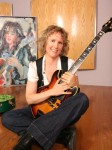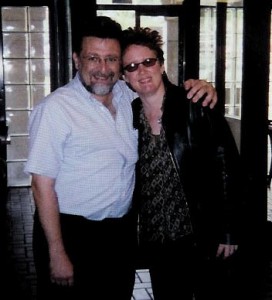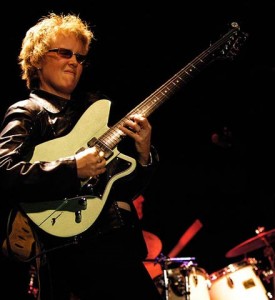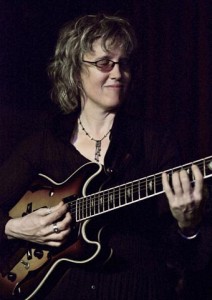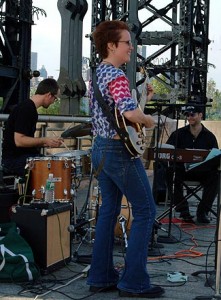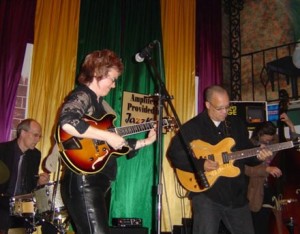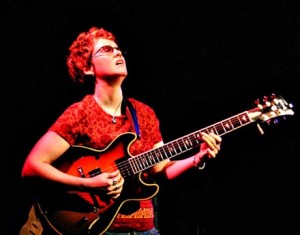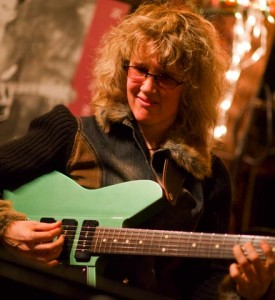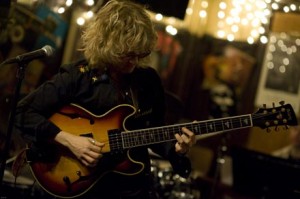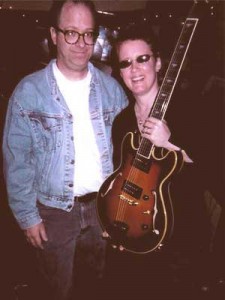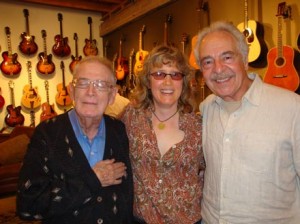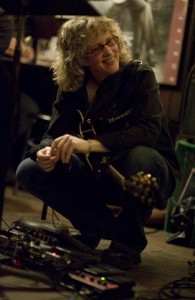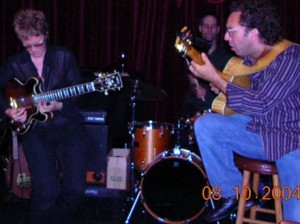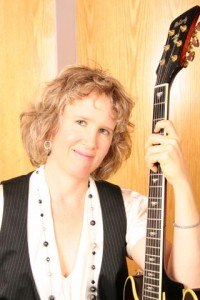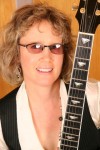
I (Doug Perkins) interviewed Sheryl Bailey through the modern miracle of Skype in her Bronx NY apartment on a Sunday afternoon Sept. 21, 2014. It was cool to get to see her space and pictures and of course guitar. She’s a very fun, intelligent and open person to talk to who totally knows the subject of guitar, and we got along great!
SB: So, where do we start?
DP: Well, where I like to start is finding out what makes an artist decide to play the guitar in the first place.
SB: Well, I come from a family of professional musicians – classical musicians…
DP: Oh really???
SB: Yeah, I had to take piano lessons, and everyone’s a lot older than me – by a big space. So I’m sure number one it was just to be different – I was a rebellious kid, kind of a wild kid…I mean like, if my piano teacher knew I was a professional musician she would be like (grabs her chest and makes a heart attack sound), because I was like horrible! (Laughs) Because I wanted to play rock music! So I begged my mother for a guitar and I got this Strat from the JC Penny catalog – like a Harmony Strat and the amp that came with it. (Both laugh)
So when I was a teenager within a couple of months I had my first basement band and then I was playing in clubs, doing like country and classic rock, and then I got into heavy metal…
DP: So when did you actually start playing guitar – how old were you?
SB: I was thirteen, but I had studied classical piano before that and I had played trumpet in the band….
DP: Yeah, I played trumpet before guitar too – so when did you start playing in clubs?
SB: When I was about 16 or 17 – you know, I wasn’t supposed to be there (laughs)
DP: Yeah, me too, the same age!
SB: OK, I can see a picture on your wall of someone behind you that looks really familiar – who is that?
SB: Jimmy Wyble!
DP: That’s it, I knew I knew who that was – OK, we’ll get into that later, I’m sure there’s a story with that!
SB: Yeah, there’s a great story about Jimmy Wyble!
DP: We will definitely come back to that, I don’t want to get ahead of the timeline here. OK, you’re sixteen – what guitar players really did it for you then?
SB: Jeff Beck! And Eddie Van Halen, he started the tapping thing – and Jimi Hendrix! I always loved Robin Trower and Frank Marino, and all those guys – and I loved that live Cream record!
DP: So when did the transition to jazz come?
SB: There was this radio station – I think it’s still there – in Pittsburgh where I grew up called WQET, and they were you know, one of those renegade radio stations. And one night I was listening to it and they played some Sonny Rollins, and some Bird and some Wes (Montgomery), and I was just so fascinated by it. So I started listening to that and I wanted to know what it was, really.
DP: Exactly – so Wes was the first jazz guitar player that you ever heard, right?
SB: Yes, and so I started studying – I was hanging out in bars and not going to school, and my mom was so upset, and I just said “well, I just want to play the guitar†and she said “well, you can go to music school, but you have to get your grades togetherâ€. So she said “I’m going to get you a teacher†and she hooked me up with this guy John Maione, who was at University of Pittsburgh in Duquesne University. And this all sort of came together at the same time, I started listening to all of this jazz stuff, trying to figure out what it was. So I started studying with him, and he got me into all of the early players: we did Charlie Christian transcriptions and Carl Cress. Eddie Lang, stuff like that – I loved that, I used to just used to eat that stuff up. (Below, John Maione and Sheryl)
DP: So he (John Maione) was definitely a jazz teacher, not just some guitar player that could play a little bit of jazz….
SB: Yeah, he was a jazz teacher. He came to my mother and said “you have to (let Sheryl) skip school and hear Tal Farlow†– this was when he had come out of retirement in the 80s. So that was the first real jazz guitarist I ever saw, the whole experience was mind blowing.
DP: So now your high school period is coming to a close – you’re still playing rock, or you’re playing jazz?
SB: I’m definitely playing jazz mostly, yeah.
DP: What kind of gigs were you doing?
SB: Well, I was still playing mostly rock gigs, I didn’t really play a jazz gig until I went to Duquesne, something like the Jazz Workshop. I just didn’t really feel like…you know…
DP: So then what, did you go to Berklee, did you go somewhere else?
SB: I went to Duquesne in Pittsburgh for a year, and then I went to Berklee to finish up for three years. I have a degree, which my mother made me do (laughing). It’s in Professional Music. They designed it back then that you could just shed all the time, it was great!
DP: I wish I would have done it – did you know that I went to Berklee as well?
SB: When were you there?
DP: Well, I know I am dating myself, but Emily Remler was in my first semester Harmony class! Back then she was wearing cowboy boots and jeans!
SB: (laughing)
DP: Speaking of Emily Remler, did you actually know her?
SB: I took a lesson with her, and I don’t know if you know this, but I did a record for her that Marty Ashby called “A New Promise†on MCG Jazz. And it was released on the 20th anniversary of her death, which was about 2-3 years ago now. I did see her once in Pittsburg and had an amazing opportunity mainly because of Joe Negri, who brought in everybody: Joe Pass, Herb Ellis, Tal Farlow, and Emily Remler. So when I had my first break from Berklee I went back to Pittsburg and she was in town so my friend said “hey, take a lessonâ€. She was a great teacher and she was very giving too, she hung out with me all day and she wasn’t like “hey kid…†and checking her watch, and everything that she gave me I use as a player AND as a teacher all the time. So that was the only time that I hung with her but she was very encouraging to me. And then flash forward to when we did that big band record for her and Marty and Jay Asby were both good friends with her, so I really went back and did a lot of research on her through that “All Things Emily” web page (http://allthingsemily.com/ ), and there were a lot of interviews with her there and I wanted to hear her voice in my head – like her talking voice. So I just watched al of those interviews with her and stuff, and I think we make a nice tribute to her. And you know, I‘m still surprised at how many people don’t know about her work, I think she was a great composer and a great teacher besides a great player.
DP: Here’s a related question that just occurred to me: The jazz world is sort of “the boys clubâ€, right? Have you had any issues with that, being a woman in that world?
SB: Well, not to my FACE! (laughing). But to be honest, I’m sure there are probably some people that don’t hire me because of that, but if I sat around and thought of that I’d probably be depressed. I’m a forward thinker and I just try to focus on playing the guitar the best that I can, and that’s why I create my own projects and stuff like that, you know, maybe that’s my path. So it does exist, but it’s not something that I can be bothered with, really. I mean, there’s only one list, people say to me “you’re the best female guitaristâ€, there’s only one list that I care to be on. You’re either a great guitarist or you’re not, you can play or you can’t, and that’s it. You don’t think about Wes as a great male guitarist, or Tal Farlow as the best male guitarist, you go “that’s great guitar playingâ€. So if you hear my record, I want you to go “that’s great guitar playingâ€, that’s what my goal is. No qualifiers, I’m thinking bigger than that.
DP: That’s a great way to look at life and music in general. So back to the time line: what were the major changes that happened for you in your playing at Berklee?
SB: Well, since I had studied with John (Maione) and also Joe Negri – he’s the guitarist on “Mr. Rogers Neighborhoodâ€, the handy man, he’s like a local TV legend in Pittsburgh, he’s kind of like a Johnny Smith kind of player – so I was coming out of that. And I’m really glad because they gave me such a good foundation in chord solos and all of that. So I think it was just getting into modern harmony at Berklee, and harmonic analysis, I still believe it’s the best anywhere. And I got into players like Mike Stern and John Abercrombie, I loved what he did with Ralph Towner…
DP: Yeah, Sargasso Sea and tunes like “The Jugglerâ€â€¦.
SB: Yeah, all that ECM stuff, that was so hot then, and I just opened up to modern harmony there. Also Mick Goodrick – “Summer Band Camp†and all of those kind of tunes – I really wanted to get into that. I had come from the really math minded generation and I wanted to know how all of that worked, like the Giant Steps video I did for JGS.
DP: Yeah, that’s a great Master Class – so it seems from what you’re saying that you probably read pretty well, is that right?
SB: I can read, yeah, I can read pretty good…Steve Slagle said that I’m the best reading guitarist, but I think he’s out of his mind (laughs).
DP: There are all different kinds of sight reading for sure…
SB: It’s crucial – there’s all of these adults that are so stubborn about not learning to read, but if you’d just take six months to a year and do it, you’d get all of your basics together, you’ll learn your instrument in that way.
DP: That brings up a good subject: what’s YOUR method for teaching somebody to read on the guitar?
SB: I just use those Berklee books (Modern Method For Guitar, etc.)!
DP: So you start in open position, and then you go to second position….
SB: …and then right on up through the neck. And then I balance that with technical reading, and then practical reading: playing tunes and reading solos, and classical pieces. But they just have to be consistent with it…
DP: And then the hardest thing is learning how to put it on the neck the easy way for you.
SB: Yeah, yeah, but you only know that from doing it a lot though! (laughs)
DP: So what are the things that YOU practice on a regular basis? What are the things that are your ongoing things to do to improve?
SB: Well, that’s a great question. I always do – and I use this as a verb as much as anything- a lot of Hanon…
DP: Define “Hanon†for those that aren’t familiar with that term.
SB: This is Hanon (laughs and holds up a book of music with a lot of scalular and intervallic technical studies) – welcome to Hanon. I use a lot of actual Hanon, but then I make up my own Hanon, so I just call it the verb Hanon. These are all written in C major, but I over the years used to learn them in harmonic minor, melodic minor, all that.
So I might do that, or what I call “melodic ideasâ€. I always start out with chords to warm up, some of the Van Eps things, the diminished things with lines moving through them, just to get my hands warmed up. But then the next step of my practice is taking Hanon and applying it to a tune. I take one of those Hanon studies and try to make those patterns fit the harmony of a tune.
And then I like to take some time every day just soloing with chords, and then whatever I have to do from there – but that’s like the core of what I touch on every day.
DP: Wow, that is a really disciplined approach! So, now tell us about some of the big influences on you, and how you met some of the people that you’ve come to play with.
SB: Well, from when I was a teenager and all through Berklee it was Wes (Montgomery). I mean, I used to play all of those solos…and Pat Martino, I think that’s kind of apparent in my playing.
DP: Did you play the Wes stuff with your thumb at all, or did you just play it with a pick?
SB: Back then, but now I play it with a pick…well, I go back and forth, but back then I think I played it with my thumb. And then Grant Green….uhh…definitely Mike Stern. And when I left Berklee I moved to Baltimore, and the scene there was like funk fusion, and so if people have my first record it’s a fusion thing, like shredding fusion. So I was really coming from playing bebop in that setting with overdrive and all of that, but that was the scene down there. Dennis Chambers was down there and I played a lot with (bassist) Gary Grainger and this drummer Larry Bright, and this amazing bass player who died who was a very good friend of mine Vince Loving who was on my first record.
So that was my first stuff including writing wise, and that whole Miles thing with Marcus Miller was going on, so my writing came out of that too then. So I have to say that really when I returned to New York – I’ve been on New York for 20 years now – it was interesting because it was a return to tradition. I felt like I really started with the traditional stuff, and then I got into modern stuff – the fusion stuff – in Baltimore, but coming back to New York was coming back to the tradition.
DP: What made you decide to go to New York?
SB: Because I realized that I needed to go there to reach my potential as a player, to be amongst the greats. And also for my career, to get better opportunities to play with better players. I think that New York is sort of the big pond, so you become a big fish in a small pond, and then all the big fish pour into the big pond. (Laughs) And that’s the big soul searching thing for everybody, and finding yourself, finding your voice. So it was just going back to the straight-ahead thing, just playing guitar, no effects, just right there. (Laughs) So even now I still do a lot of different things and people are often shocked when they come across things of me shredding, but that’s how I started out, and I still love to do it.
DP: Now tell me about some of the well-known musicians that you’ve met and played with, and how that came about.
SB: Well, I guess one of my earlier gigs was with Richard Bona, the bass player.
DP: I love him!
SB: And I have to say, and I’m sure you find this as well, that every gig I’ve ever gotten came out of the most unlikely place. So I used to work with this singer-songwriter and she had this bass player from Senegal, Mamadou Ba; who was playing with Regina Carter and Leni Stern and a lot of people, he’s a great bass player. So anyways, his best friend was Richard Bona. So Richard used to come to meet him at the club and I never knew Richard was there – I’m glad, because I probably would have been really nervous. So I don’t know, I got a call from him – let’s see, I started working with him in 2001, so I got a called in December of 2000 “Do you want to go to Japan with Richard Bona?â€, and I said “Wow, I didn’t even know he knew me!â€, you know what I’m saying? And that’s what I tell my students and I think is the lesson of New York: always play your best, because you never know who is in the audience. I’ve played gigs where Mike Stern was there and you never know, so you should always play your best. So that was an amazing an interesting connection.
DP: I remember I saw Richard Bona with the Zawinul Syndicate and I told all of my bass player friends that I just saw the best electric bass player in the world – he literally blew me away.
SB: Yeah, he’s pretty amazing! So I did that gig for several years, and I’ve worked with people like (jazz clarinetist and tenor sax player) Ken Peplowski , and then of course a lot of the guitar players like Jack Wilkins and Howard Alden, we’ve done different collaborations together. Right now I’m working with (bass virtuoso) Harvie S, we just mixed a project.
DP: What kind of project?
SB: An acoustic guitar and bass duo, I hope it will be out at the beginning of next year. It’s a collaboration, there are ten tunes and he wrote five, I wrote five. It’s kind of more like chamber music, but it’s all improvised…..
DP: What I call chamber jazz….
SB: We have no amplification so it’s really intimate, and no drums.
DP: What’s the acoustic guitar that you used on it?
SB: You know, I’ve never had an acoustic guitar until last year, and I do a residency in Maine every couple of years, and I met this guitar builder up there Dana Bourgious. So I went by his place and I played a few guitars, and he’s really old school – he has a company Pantheon Guitars. They used to be sort of a boutique company I believe of Martin, and so he’s really kind of a Martin fanatic. He does everything old school and he does everything by ear, when I saw him working I said “oh, that guys deepâ€. So I played a few things and then he put together something custom, it’s almost sort of parlor sized, it’s got a cutaway, short scale.
DP: With a pick-up?
SB: He doesn’t do a pick up, I put one in it but I’m not really happy with it. But for what Harvie and I are trying to do, we want it as acoustic as possible, it’s just “shhh – listen†(Laughs). (For a cool video of Sheryl playing “Voodoo Chile†with on her Dana Bourgious custom Pantheon acoustic with singer Imani Gonzalez, go to Sheryl’s tab at: http://www.pantheonguitars.com/ )
DP: Are you playing live with that duo with Harvie S?
SB: We played the other night at a new little room that opened up on Christopher St (in NYC) called the “Why Not Jazz Roomâ€. It seats something like 30 people maximum.
DP: So that’s down by Bar 55 then.
SB: Yeah, like a block away, a cool little place.
DP: So what about your live band stuff where you are leading, who do you usually use in those bands?
SB: I have an organ trio that has been together for a long time and we have a new record that came out this year on Cellar Live, a Canadian label. The drummer is Ian Froman and a great organist Ron Oswanski – we’ve had sort of a regular thing at the 55 Bar for like 14 years. So this new record was like the easiest thing I’ve ever done and I really am proud of it.
And I have quartet also though with that pianist Jim Ridl, he’s on a lot of the Pat Martino records, which is where I first saw him. So it’s him and Andy McKee on bass and a great drummer, Joe Strasser. And that bands a little bit more straight ahead, more like Wes and Wynton Kelly. That band works pretty regularly too, I think after the thing with Harvey that will be the next project that I put out.
DP: So we talked about your acoustic guitar, tell me about your electric guitar.(Below: Guitar builder Rick McCurdy and Sheryl)
SB: So this guitar is my signature model and it’s built by this guy Rick McCurdy. This particular one – speaking of Jimmy Wyble – was given to me by Jimmy Wyble. (See it here: http://www.crguitars.com/site/items/mccurdy-mercury-sheryl-bailey-model
)
DP: That guitar was given to you by Jimmy?
SB: Yeah it was a gift from Jimmy. This particular model is a little bit different. I have the original model, and then I met Jimmy, and we became friends and he wanted to give me a guitar. (Below: Jimmy Wyble, Sheryl, and John Piasano)
DP: Well how did you meet him?
SB: I was playing in LA with John Pisano, and Jimmy had just come out of retirement and there was this like beaming being there, and that was Jimmy and we became friends.
DP: Was it that Guitar Night that Pisano does at Viva Cantina?
SB: Yeah, but it was when it was at Spazios. So anyway, Jimmy said I want to have your builder make you a guitar and give it to you from me when I die, and I said “no, no, you cannot die, number one, and you cannot give me a guitar, two.†So he went to New York and he went to Rick’s and he had already built this guitar, and he picked up and he bought it for me. But he didn’t tell me and he went back to LA and then Sunday night Rick called me and said he said “Oh, Jimmy has something for you here†(laughs).
DP: Wow!
SB: So I couldn’t say no! (still laughing)
DP: It reminds me of that Hofner “Very Thin Contemporary” that he was playing.
SB: Yeah! Yeah, I guess so. So it’s kind of like a small 335….
DP: But not a stop tailpiece and you’ve got the big wooden arch top type bridge – and Strat style pick-up selector, that’s interesting…
SB: He just made me a new thing though, it’s a solid body which I just got, which I will use on some of my other crazy gigs.
DP: That short pickguard looks interesting…
SB: Yeah, and it’s got Seymour Duncan Jazz pick-ups, I think they sound really nice.
DP: And is that a Walter Woods head I see there?
SB: Yeah, that’s my home practice rig – and that cabinet Rick built for me, it’s an open back 10†speaker that’s superlight, it’s just what I use around the house.
DP: So what do you use when you go out and gig?
SB: Well, I either have a Polaris head – a Clarus 2R with reverb, from Acoustic Image (http://www.acousticimg.com/ ); and I just got this tube amp I bought used from Charlie Hunter called a Headstrong (http://headstrongamps.com/Index.html ) – it’s like a Princeton, it’s gorgeous. They’re out in the Bay area, they’re killing, man, it’s a killing little amp! So I use that a lot – I’m actually playing at the Mel Bay Jazz festival in St. Louis pretty soon, and I will just take the little Clarus head, it’s great because it has a voltage switch so I can go to Europe and just rent some speakers.
DP: OK, shifting gears here – how did you get hired at Berklee?
SB: I don’t know!! (Laughs) I’d been teaching at Towson University in Maryland, it’s in Baltimore. And I’d been teaching there and commuting to New York for a while, and I had sent them (Berklee) my resume – I had forgotten that I did. And I had done a gig playing with George Garzone, and Bruce Saunders saw me there. And he was at a faculty meeting at Berklee and they said, “we’re going to hire a new guitarist†and he mentioned my name and they said, “Oh, yeah, we have her resumeâ€. So they called me and I was like, “Wow, how did you know get in touch with me?†(laughs) Again, another one like “who saw it comingâ€?
DP: And what courses do you teach there?
SB: I just teach private lessons, but I also have a lab that I developed – it doesn’t really have a name, but I call it “The Be-Bop Lines Labâ€. And it’s been great in that I’ve really been fortunate to have that lab to be able to develop my curriculum.
DP: Do you take that curriculum with you when you go out on tour to do seminars?
SB: No, I sort of teach like a savant, if somebody just asks me a question I have curriculum ready – from doing it so much (laughs).
DP: So everyone has their thing that are difficult for them, and they might not even be technical things, but maybe just disciplines – what are the things that you find you work on the most?
SB: It’s gotta be chord solos – it’s like physically there’s much more muscle groups involved, it’s more complex – and I hear a lot of stuff that I can’t do, so I get frustrated. So that’s a hard thing – I think my main obsession in life it rhythmic clarity and harmonic clarity, you know? That’s what I’m always striving for all the time.
DP: Do you have any devices that you use for going outside of the harmony?
SB: I don’t know, because I think that’s really relative to what you hear as being outside. There are people who say that a #11 is outside, and they say “you play really outside†and I say, “man, I play really IN†– as far as I think, to my ear. In fact, Gary Thomas – speaking of an early big time gig, he teaches at Peabody in Baltimore now(director and chair of jazz studies) – what really fascinated me about him was what he would hear on a chord. And I used to work out of this atonal ear training book that I need to get back into – did you ever work out of this book called Modus Novus? (http://www.amazon.com/Modus-Novus-Lars-Edlund/dp/084644156X ) It’s beautiful book that starts with seconds and then goes to 4ths and 5ths, and I would try to sing those over like a major triad. Because I was so fascinated because you could play a chord like a butt ugly maj7 for that guy (Gary Thomas) and the kinds of melodies he would construct was like wow! Because he HEARS that, and that always fascinated me – so I think that out is relative to what your EARS hear. (Below: Sheryl and Anthony Wilson)
DP: So you’re doing this festival in St. Louis – I never knew there even was a Mel Bay festival before!
SB: Second annual! I think it’s sort of small and there are just a couple of artists and we are doing three sets sort of rotating in different locations. It will be the organ trio and Ron could not make it this time, so Pat Bianchi (http://www.patbianchi.com/ ) is playing organ, he’s playing with Pat Martino so everybody knows him from that gig.
DP: Whenever you have a band these days, you have to have at least three guys you can call on any instrument.
SB: Yeah, and I have three great guys I can call at anytime.
DP: What about future plans stuff?
SB: Well, I have a lot of touring coming up – I work with this band called Ancestral Groove (http://davidkrakauer.com/ancestral-groove/ ) and this fall we will be in Germany, Poland and all over Europe. It’s led by this clarinetist David Krakauer who is like a Klezmer master. I’ve worked in many of his projects and this one is more bare bones – Jerome Harris is playing bass, who is also a great guitar player, and a great drummer Michael Sarin. It’s more funk oriented, like funk Klezmer….
DP: (laughs)
SB: So I’m always shedding my harmonic minor before I go out with him. It’s really interesting because he’s really also into the avant-garde and he’s also really into Sidney Bechet. He has another project that we will be in Denver for in October, it’s more like a show and it’s called “The Big Pictureâ€, and we play with these amazing computer animations. I haven’t actually seen the show myself because I’m playing it, but it’s also an amazing band that includes Mark Elias on bass, Sara Caswell on violin (http://saracaswell.com/ ) and Rob Schwimmer playing Theremin (http://www.robschwimmer.com/ ), I play acoustic and electric in that band. So anyway I have a bunch of stuff with those two projects and I am always busy with David’s adventures (laughs).
DP: So you commute into Boston from the Bronx how often?
SB: I go in on Monday morning and come back Tuesday night, it’s about 3 hours and 20 minutes from the Bronx.
DP: What time’s your first student?
SB: One o’clock on Monday.
DP: Thank God – if it was 10am that would be bad! What else do you want to say that I didn’t cover?
SB: Well, I just hope that they enjoy my new JGS master class, but also they should go to my webpage and check out my new CD, and if they get it through me they get a free documentary with it. It’s a 15minute documentary on the making of the project.
For more on Sheryl Bailey, go to: http://www.sherylbailey.com/
